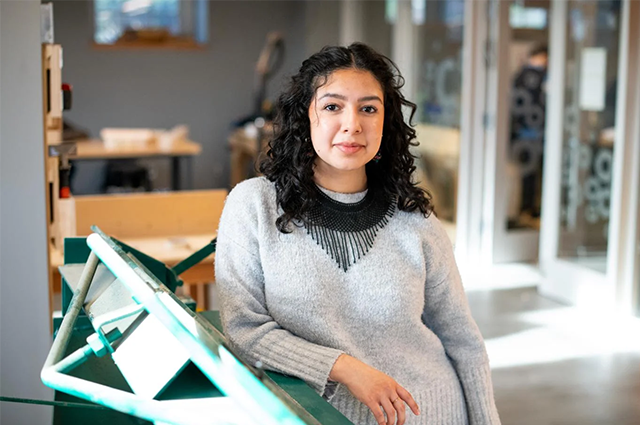Inventive by nature, engineers by calling: Leslie Jaramillo Martinez, E23

Leslie Jaramillo Martinez, E23
Born in Mexico and raised in Dallas, Leslie Jaramillo Martinez is majoring in mechanical engineering, a discipline that allows her to follow her fascination for product design, manufacturing, and sustainable technologies. She also brings a passion for advancing diversity, equity, inclusion, and social justice to activities outside the classroom, including as president of the DEIJ Mechanical Engineering Board, as a STEM ambassador for the Center for STEM Diversity, and a former peer leader and intern with the Latinx Center. She is also a mentor for other first-generation and/or low-income students as a learning assistant in three mechanical engineering courses. Internships with high-tech companies such as Cree, Abbott Neuromodulation, and Formlabs have expanded her fabrication expertise and interest in innovation.
“Whenever I'm working on design, I forget that time is moving on. It feels like time is frozen. You come up with one idea and then your brain comes up with other random ideas; it’s a web of ideas. That only happens when I’m designing. So I enjoy coming up with all these out-of-the-box ideas and actually building them. I can see my ideas come to light in a way that is useful; that process makes product design and fabrication really cool.
“One class, ME30, [Electromechanical Systems and Robotics taught by Lecturer Brandon Stafford and Associate Professor Kristen Wendell] for instance, gave me a chance to figure out electronics. We had to invent a game that had never been built before, the user had to input something, and something would have to tell the user whether they had won.
“So I thought of this game I used to play with my brother: It was ‘soccer’ we could play just about anywhere! We would roll up a tiny ball of tissue paper and then just ‘kick’ it with two fingers. To block it, you’d move your fingers back and forth. For my project, I made the goalie be a motor that would move constantly back and forth, and I could adjust the speed. I also 3D printed a net. A player kicks a marble at the goal and if they hit the net, or score, it presses a button, the motor stops, and a light goes on so they know they won. That was a really hard project! I spent probably 30 hours working on it, but it was a fun challenge. Over the summer I wanted to keep working on the game and I even designed little shoes for fingers; I realized they only fit my fingers! I ended up just 3D printing ones for myself.
“Something that I've learned during my four years here, and that I hope I can help change, is that the definition of engineering, and the idea of ‘engineering’ something that is new, is too narrow. My parents didn’t go to college, but they’re engineers, in that they value making things, and they had a big influence on my childhood. I made a doghouse from scratch with my father; my mother always encouraged me to draw. And my grandfather was my first introduction to engineering.
“He has a small farm in Mexico where he raises all his own food, and everything he builds is useful to him on his farm. He makes all these weird tools from found materials. For example, he has two donkeys that help him with crop cultivation, and he added nails along the bottom of a piece of wood and then he hooked that piece of wood to the two donkeys to make a plow. He'll stand on top of the wood and it would create the furrow for seeds; he could drive the donkeys and simultaneously sow his seeds. Before, he had to pull the donkeys and then go back and plant his seeds, which also required a lot of bending.
“To me he was an engineer. His ideas have really inspired me. And I would say, to anyone who is questioning whether they belong in engineering: they absolutely do. We all belong in engineering.”
Department:
Mechanical Engineering